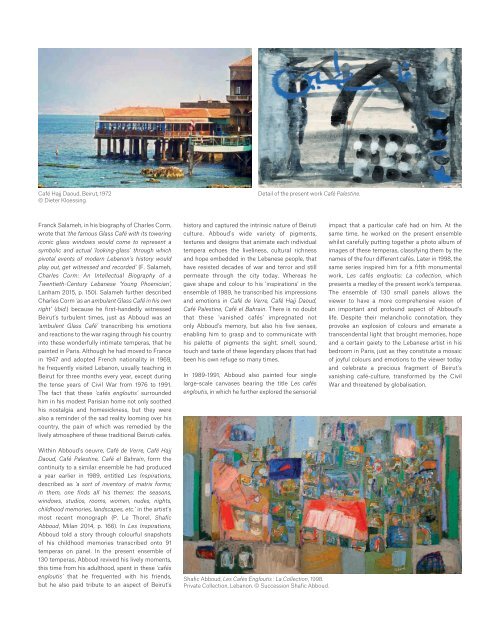NOW AND TEN
DUB1241_SaleCat
DUB1241_SaleCat
Create successful ePaper yourself
Turn your PDF publications into a flip-book with our unique Google optimized e-Paper software.
Café Hajj Daoud, Beirut, 1972<br />
© Dieter Kloessing.<br />
Detail of the present work Café Palestine.<br />
Franck Salameh, in his biography of Charles Corm,<br />
wrote that ‘the famous Glass Café with its towering<br />
iconic glass windows would come to represent a<br />
symbolic and actual ‘looking-glass’ through which<br />
pivotal events of modern Lebanon’s history would<br />
play out, get witnessed and recorded’ (F. Salameh,<br />
Charles Corm: An Intellectual Biography of a<br />
Twentieth-Century Lebanese ‘Young Phoenician’,<br />
Lanham 2015, p. 150). Salameh further described<br />
Charles Corm ‘as an ambulant Glass Café in his own<br />
right’ (ibid.) because he frst-handedly witnessed<br />
Beirut’s turbulent times, just as Abboud was an<br />
‘ambulent Glass Café’ transcribing his emotions<br />
and reactions to the war raging through his country<br />
into these wonderfully intimate temperas, that he<br />
painted in Paris. Although he had moved to France<br />
in 1947 and adopted French nationality in 1969,<br />
he frequently visited Lebanon, usually teaching in<br />
Beirut for three months every year, except during<br />
the tense years of Civil War from 1976 to 1991.<br />
The fact that these ‘cafés engloutis’ surrounded<br />
him in his modest Parisian home not only soothed<br />
his nostalgia and homesickness, but they were<br />
also a reminder of the sad reality looming over his<br />
country, the pain of which was remedied by the<br />
lively atmosphere of these traditional Beiruti cafés.<br />
history and captured the intrinsic nature of Beiruti<br />
culture. Abboud’s wide variety of pigments,<br />
textures and designs that animate each individual<br />
tempera echoes the liveliness, cultural richness<br />
and hope embedded in the Lebanese people, that<br />
have resisted decades of war and terror and still<br />
permeate through the city today. Whereas he<br />
gave shape and colour to his ‘inspirations’ in the<br />
ensemble of 1989, he transcribed his impressions<br />
and emotions in Café de Verre, Café Hajj Daoud,<br />
Café Palestine, Café el Bahrain. There is no doubt<br />
that these ‘vanished cafés’ impregnated not<br />
only Abboud’s memory, but also his fve senses,<br />
enabling him to grasp and to communicate with<br />
his palette of pigments the sight, smell, sound,<br />
touch and taste of these legendary places that had<br />
been his own refuge so many times.<br />
In 1989-1991, Abboud also painted four single<br />
large-scale canvases bearing the title Les cafés<br />
engloutis, in which he further explored the sensorial<br />
impact that a particular café had on him. At the<br />
same time, he worked on the present ensemble<br />
whilst carefully putting together a photo album of<br />
images of these temperas, classifying them by the<br />
names of the four diferent cafés. Later in 1998, the<br />
same series inspired him for a ffth monumental<br />
work, Les cafés engloutis: La collection, which<br />
presents a medley of the present work’s temperas.<br />
The ensemble of 130 small panels allows the<br />
viewer to have a more comprehensive vision of<br />
an important and profound aspect of Abboud’s<br />
life. Despite their melancholic connotation, they<br />
provoke an explosion of colours and emanate a<br />
transcendental light that brought memories, hope<br />
and a certain gaiety to the Lebanese artist in his<br />
bedroom in Paris, just as they constitute a mosaic<br />
of joyful colours and emotions to the viewer today<br />
and celebrate a precious fragment of Beirut’s<br />
vanishing café-culture, transformed by the Civil<br />
War and threatened by globalisation.<br />
Within Abboud’s oeuvre, Café de Verre, Café Hajj<br />
Daoud, Café Palestine, Café el Bahrain, form the<br />
continuity to a similar ensemble he had produced<br />
a year earlier in 1989, entitled Les Inspirations,<br />
described as ‘a sort of inventory of matrix forms;<br />
in them, one fnds all his themes: the seasons,<br />
windows, studios, rooms, women, nudes, nights,<br />
childhood memories, landscapes, etc.’ in the artist’s<br />
most recent monograph (P. Le Thorel, Shafc<br />
Abboud, Milan 2014, p. 166). In Les Inspirations,<br />
Abboud told a story through colourful snapshots<br />
of his childhood memories transcribed onto 91<br />
temperas on panel. In the present ensemble of<br />
130 temperas, Abboud revived his lively moments,<br />
this time from his adulthood, spent in these ‘cafés<br />
engloutis’ that he frequented with his friends,<br />
but he also paid tribute to an aspect of Beirut’s<br />
Shafc Abboud, Les Cafés Engloutis : La Collection, 1998.<br />
Private Collection, Lebanon. © Succession Shafc Abboud.


